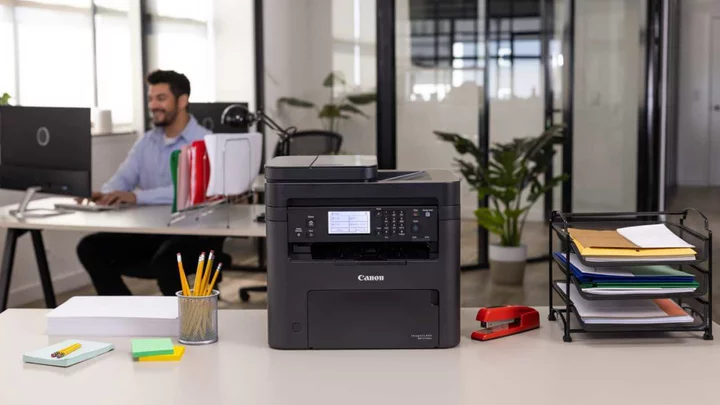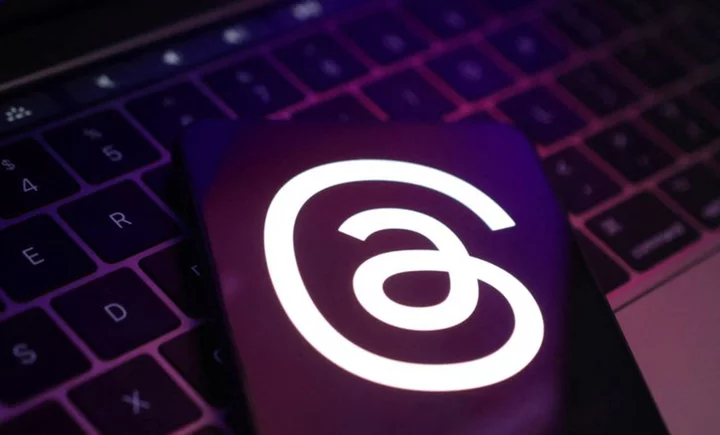The Canon imageClass MF275dw ($219.99) violates the rule of thumb for printers that higher numbers in otherwise identical model names mean greater capability. Compared with individual printers in the Canon MF260 II series, the MF275dw actually offers less in some cases, and trade-offs in others. It's less expensive than the imageClass MF269dw II, for example, and it shares most of the same features, but doesn't match the MF269dw II's paper handling for printing or scanning. Compared with the imageClass MF264dw II, it costs about the same, largely matches it in most features and adds faxing, but it still comes up short on paper handling. That said, the MF275dw is a solid choice if its level of paper handing is adequate for you, and if heavy-duty MF450-class printers like the Editors' Choice-winning MF455dw are overkill for your needs and budget.
Quick and Easy Setup
The MF275dw is a typical size and weight for a small-office mono laser multifunction printer: a little too big to comfortably share a desk with, but small enough to easily find space for, at 14.4 by 15.4 by 14.6 inches (HWD) and 24.7 pounds.
Physical setup is easy. Set it in place, remove the packing materials, load paper, and plug it in. The toner cartridge comes already installed and ready to work. Software installation was just as easy in our tests. Canon provides an installation disc that handles almost everything automatically. All I had to do was tell the program to connect using Ethernet and confirm that it found the right printer. It even updated the firmware through the network connection automatically. In addition to Ethernet, connection options include USB, Wi-Fi, and Wi-Fi Direct. The printer also supports mobile printing.
(Credit: Canon)Paper handling is suitable for light-to-moderate-duty printing in a small or home office, but more "light" than "moderate," despite the automatic duplexing (for two-sided printing). You get only one tray, which can accept up to legal-size paper, and the capacity is only 150 sheets. The tray, at the bottom front, sticks out a little from the printer body, with no cover, making it a lot easier to load than a drawer you have to slide in and out. However, the lack of a second tray, or even a single-sheet bypass feed, means you'll need to swap out the paper in the tray or add the new paper to the top of the stack every time you need to switch the paper size or type.
Canon recommends a monthly duty cycle of 200 to 2,000 pages, but a more realistic maximum, assuming you'd rather not be refilling the tray more than about once a week, would be 600 sheets per month, or about 30 sheets per business day.
(Credit: Canon)For scanning, the MF264dw II offers a letter-size flatbed and a 35-page ADF for up to legal-size pages. Typical in this price range, it can't scan both sides of a stack of pages and assemble the scanned pages in the right order, even with a manual assist. The only way to scan in duplex is on the flatbed, manually scanning each side of each page, one at a time. If you expect to scan multipage duplex documents at all, this is likely a deal breaker. On the bright side, it has a menu option for copying single-sided originals to two-sided copies.
Running cost is typical for the category. Toner cost, based on the printer's high-capacity toner cartridge, works out to 3.35 cents per page, with the drum included as part of the cartridge. As always, keep in mind that the number that matters most is the total cost of ownership—running cost plus initial cost. We cover how to estimate the total cost in our guide to how to save money on your next printer.
Testing the Canon imageClass MF275dw: Matching the Competition
For our performance tests, I compared the MF275dw with the Lexmark MB2236i, Brother MFC-L2717DW, and the Canon MF264dw II. All three currently sell for about the same price as the MF275dw, and all offer a higher paper capacity. The Lexmark and Brother models also have slightly faster speed ratings, while the MF264dw II shares the same rating as the MF275dw. Note that the MF269dw II also shares the same rating as the other two Canon models, and although its results aren't included in the charts shown here, it handed in nearly identical performance to both the others in our tests.
For our full 12-page Word file, there was little difference in speed among the four printers. However, the two Canon printers tied for fastest first page out (FPO) time, while the Brother and Lexmark printers tied for first place for pages 2 though 12. These different strengths happened to cancel each other out at the 12-page mark. However, if you print primarily one- or two-page documents, either Canon printer will be enough faster than the other printers to notice, if only by a few seconds. If you primarily print documents much longer than 12 pages, the Brother and Lexmark models will be faster enough than the Canon printers to notice.
On the full business applications suite, which adds Excel, PowerPoint, and PDF documents that include color and graphics and are each one to four pages long, the two Canon printers were essentially tied for first place. The MB2236i was third. These results appear to be primarily due to the FPO times, since the difference in total time from one printer to the next comes relatively close to matching the difference in FPO time multiplied by the number of files in the suite.
Text quality for the MF275dw barely missed being top tier for a mono laser. Characters offered crisp edges, and most of the fonts we test that would likely be used in business documents were easily readable and well-formed at 4 points, while all passed both tests at 5 points. In addition, one of the two highly stylized fonts with heavy strokes was easily readable and well-formed at 8 points, which is typical for mono laser output. The other was well-formed at 12 points, and easily readable even at 8 points, which is a little better than typical.
(Credit: Canon)Graphics output showed everything it was meant to show, but some individual graphics were at a level that you might not consider acceptable for times you need to convey a sense of professionalism. I saw some posterization (shading changing suddenly where it should change gradually) in a hard-to-reproduce gradient, as well as some subtle dithering patterns in fills and minor uneven pile height in solid black fills, though the last was visible only when light reflected from a small range of angles. Similarly, a dark gray line on one line chart with a black background didn't stand out as well as it ideally should, and although a single-pixel-wide line on the same background held well enough to see easily, it was only partly filled in. Photos also showed dithering, but they were just short of top tier for a mono laser, and easily good enough for printing handouts that include photos.
Verdict: A Solid Choice, But Check the Paper Handling
The MF275dw delivers good-enough performance and output quality to be well worth considering, as long as its level of paper handling is a good match for your print and scan needs. If you print enough that you'll have to refill the 150-sheet tray too often for comfort, or you change paper types often enough that swapping out the paper may become a chore, consider any of the other models mentioned here. Each one offers a 250-sheet drawer plus a single-sheet bypass tray for greater convenience when printing a sheet or two of a different paper type than you normally use.
Among them, the Canon MF264dw II is the only one without faxing, which obviously rules it out if you need the feature. The Brother MFC-L2717DW and Canon MF269dw II both offer standard analog faxing over phone lines, while the Lexmark MB2236i offers faxing over the internet.
Also be sure to consider paper handling for scanning. Of the models mentioned here (excluding the more-expensive MF455dw), the MF269dw II is the only one that supports duplex scanning. As a direct result, it's also the most expensive, though well worth the price if you need the feature, and still much more affordable than heavy-duty options like the MF455dw, our top pick for mono laser AIOs. If you don't need duplex scanning, the MF275dw could be the best fit, though its smaller paper capacity keeps it from being a clear choice.









